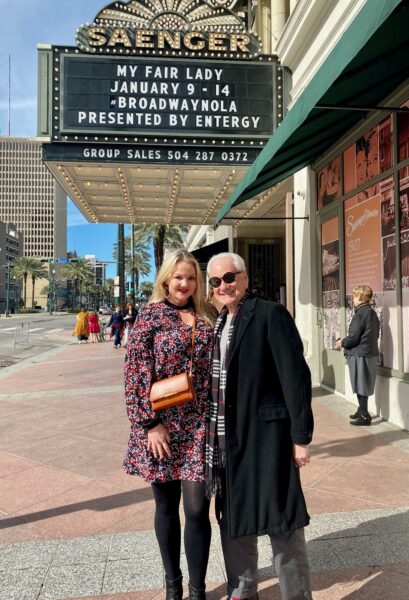Dispatches from Home: Is Change Really Necessary?

Greetings! What a glorious, fun time Juliana and I had in New Orleans today! We had lunch at Domenica and what a feast for the palate it was. We began with a delicious appetizer of polenta and pecorino romano meatballs. That segued into our mail courses. She—Tagliatelle, slow-cooked rabbit with mushrooms. Me—Squid Ink Tagliolini with blue crab and herbs. A dry, white Chardonnay for me lady, and coffee and sweet cream for moi. Desert! Yum! Mocha tiramisu with mascarpone cream espresso, Savoiardi biscuits topped with creamy-rich dark chocolate.
We then sauntered through the gilded, sculpted splendor of the Roosevelt Hotel lobby, with it soring columns, massive oil paintings, richly inlaid tile floors, and sparkling chandeliers. The elegant front entrance, with its brass revolving door and red carpet, lead us out onto bustling Barrone Street. The air was cool, the breeze mild, and the mood festive. A brisk walk landed us at our next destination: The Saenger Theater, a resplendent 1920’s movie palace that drips with old-world elegance, marble floors, grand staircases, and a sea of crystal chandeliers.
As the theater filled to capacity, we took our seats. The house lights slowly dimmed, the gilded columns faded, and in the simi-darkness, the all to familiar overture to “My Fair Lady” sored up from the orchestra pit, filling the theater with it tantalizing music. And then, with a smooth glide, the curtain went up and we were whisked back to Edwardian England! There it was with its pomp and circumstance, it’s noble architecture and its elegant ladies in glistening jewels, swathed in haute couture gowns, on the strong arms of handsome men in tails. And hovering in and out of these wealthy scions of society were the dirt poor flower sellers, the smelly, dirty dustmen, and other Dickensian characters. I was blown away!
All classic musicals are long, and I expected that. But when the curtain rained down on Act I, I looked at Juliana and we both wonder where the past hour and a half had gone. The lilting songs, the top-tapping choreography, the amazing, moving sets, coupled with the energetic actors helped create a mesmerizing show that plugged the hour-glass of time, allowing us to savor all its entertaining beauty.
Classic musicals have a certain panache, too. A mystique that has marinated over the years, which captures their audiences from the overture to the curtain call. Because of that mystique, I think audiences expect a classic musical to remain just that: Classic. Today’s performance held me in its arms until the last fifteen seconds of the show. I looked at Juliana. She looked at me. we both frowned. A lady sitting next to us asked, “Did Eliza just walk out on Higgins? I thought the show was supposed to end on a happy note.” And so did we! Classic musicals usually do.
Director Bartlett Sher may think he has not changed the classic ending of “My Fair Lady,” but to me he has. He may think that he has “interpreted” the ending in a manner that Bernard Shaw, who wrote “Pygmalion” on which the musical is based on, would approve. “The fact that she walked away in the end is just so timely and perfect for #MeToo,” Stuart said. “I think it was perfect for her character too… The story of a man denigrating his female pupil could raise some alarm.”
Ladies and gentlemen, must all art, literature, and even theater, be pulled and pushed through the knothole of today’s “standards?” Must we reinterpret everything though our eyeglass of what’s “perfect” or might “raise some alarm.” We cannot judge yesterday by today’s standards. I will not step behind the parapet and await the arrows of indignation.



